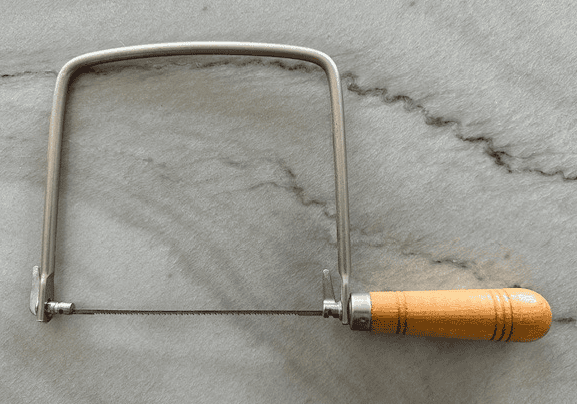A coping saw is a type of hand saw used to cut intricate external shapes and interior cutouts in woodworking or carpentry. It is particularly useful for cutting curves and delicate shapes in thin materials such as wood, plastic, or metal. The saw consists of a thin, narrow blade held under tension in a U-shaped frame, with the blade’s teeth oriented towards the handle for making precise cuts.
History
The coping saw has been a vital tool for woodworkers since the 16th century. It was designed to address the need for more precise and intricate cutting than what traditional saws could provide. The saw’s name derives from its primary function: coping, a woodworking technique that involves shaping the end of a piece of wood so it can fit snugly against another piece. Over the centuries, the coping saw has evolved in design and materials, yet its basic structure and purpose remain unchanged, testifying to its enduring utility in fine woodworking.
Types of Coping Saws
- Standard Coping Saw: The traditional coping saw with a fixed frame and replaceable blade.
- Adjustable Frame Coping Saw: Allows for adjustment of blade tension and angle for more precise cuts.
- Deep Throat Coping Saw: Features a deeper frame for cutting larger workpieces.
- Professional Grade Coping Saw: Made with higher-quality materials for durability and precision.
Coping Saw Key Features
- Thin, Replaceable Blade: For making detailed cuts.
- U-shaped Frame: Provides tension to the blade.
- Rotatable Blade: Allows for cutting at various angles.
- Ergonomic Handle: Ensures comfort during prolonged use.
- Lightweight Design: Enhances control and maneuverability.
Choosing the Right Coping Saw
Selecting the right coping saw depends on the type of projects you plan to undertake. For general woodworking, a standard coping saw suffices. However, if you work on larger pieces or require more precision, an adjustable frame or deep throat coping saw might be better suited. Professional-grade coping saws are ideal for those who demand durability and high performance from their tools. Consider the handle’s comfort, the ease of blade replacement, and the saw’s overall build quality when making your choice.
Recommendations
Proper Use and Techniques
To use a coping saw effectively, start by securing your workpiece. Use a steady hand to guide the saw, allowing the blade to do the work without applying excessive force. The blade can be rotated to navigate tight curves and intricate shapes. Maintain a slow and controlled sawing motion to prevent the blade from bending or breaking. Practice on scrap material to hone your skills before tackling more delicate projects.
Maintenance and Care
Regular maintenance of your coping saw ensures its longevity and performance. Keep the blade clean and free of debris after each use. Lubricate the blade occasionally to prevent rust. Check the frame for any signs of damage and ensure the blade tension is properly adjusted. Replace worn or damaged blades promptly to maintain cutting efficiency and precision.
Coping Saw Safety Tips
Safety is paramount when using a coping saw. Always wear safety glasses to protect your eyes from flying debris. Secure your workpiece firmly to prevent movement during cutting. Keep your hands and fingers clear of the blade’s path. Use the saw in a well-lit area to ensure accuracy and avoid accidents. Lastly, handle the saw with care, especially when replacing blades, to avoid injury.
Conclusion
A coping saw is an indispensable tool for any woodworker or DIY enthusiast looking to achieve precise, intricate cuts. Understanding the different types, features, and proper techniques can enhance your woodworking projects, making the coping saw a valuable addition to your toolkit. With regular maintenance and adherence to safety guidelines, this versatile tool will serve you well for years to come.


